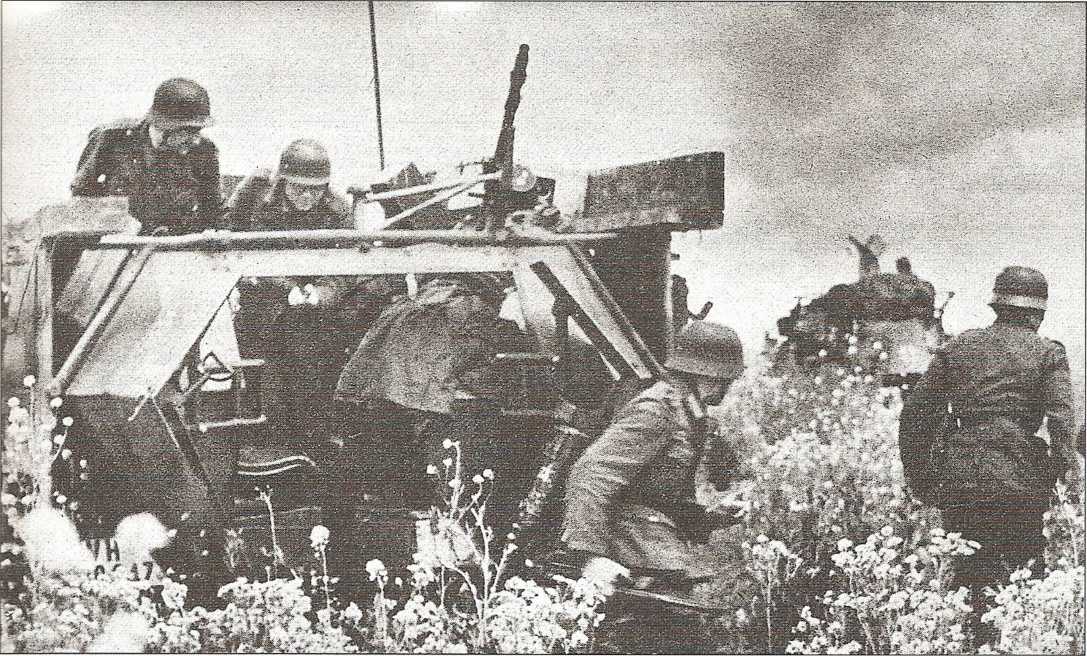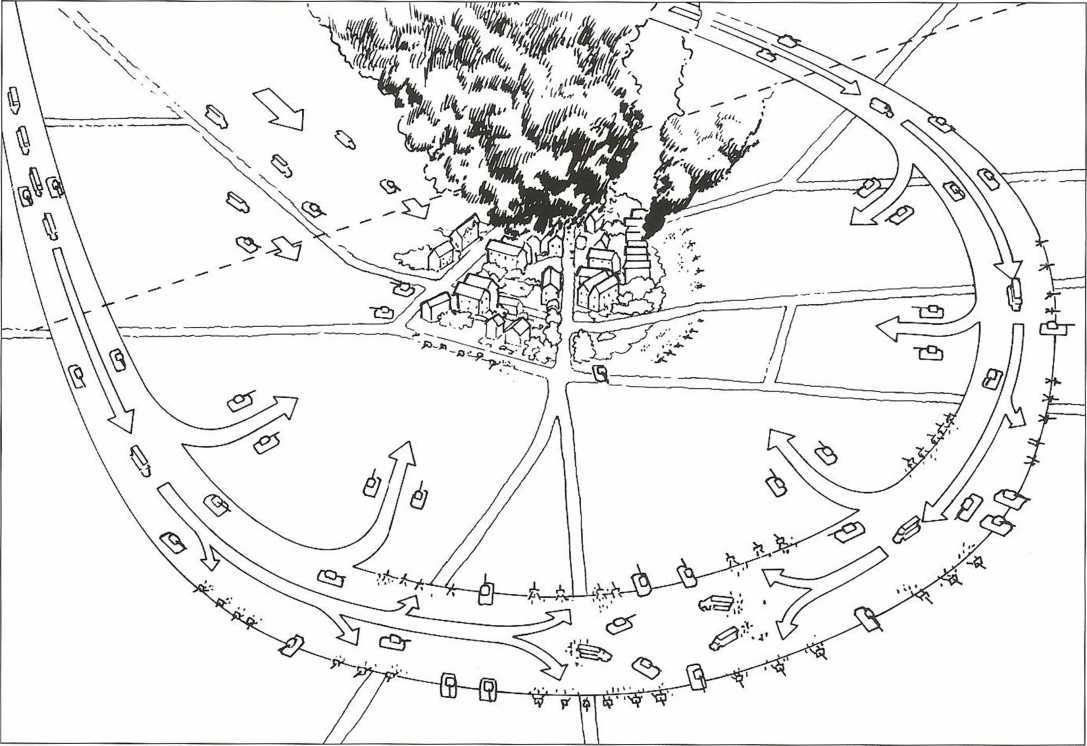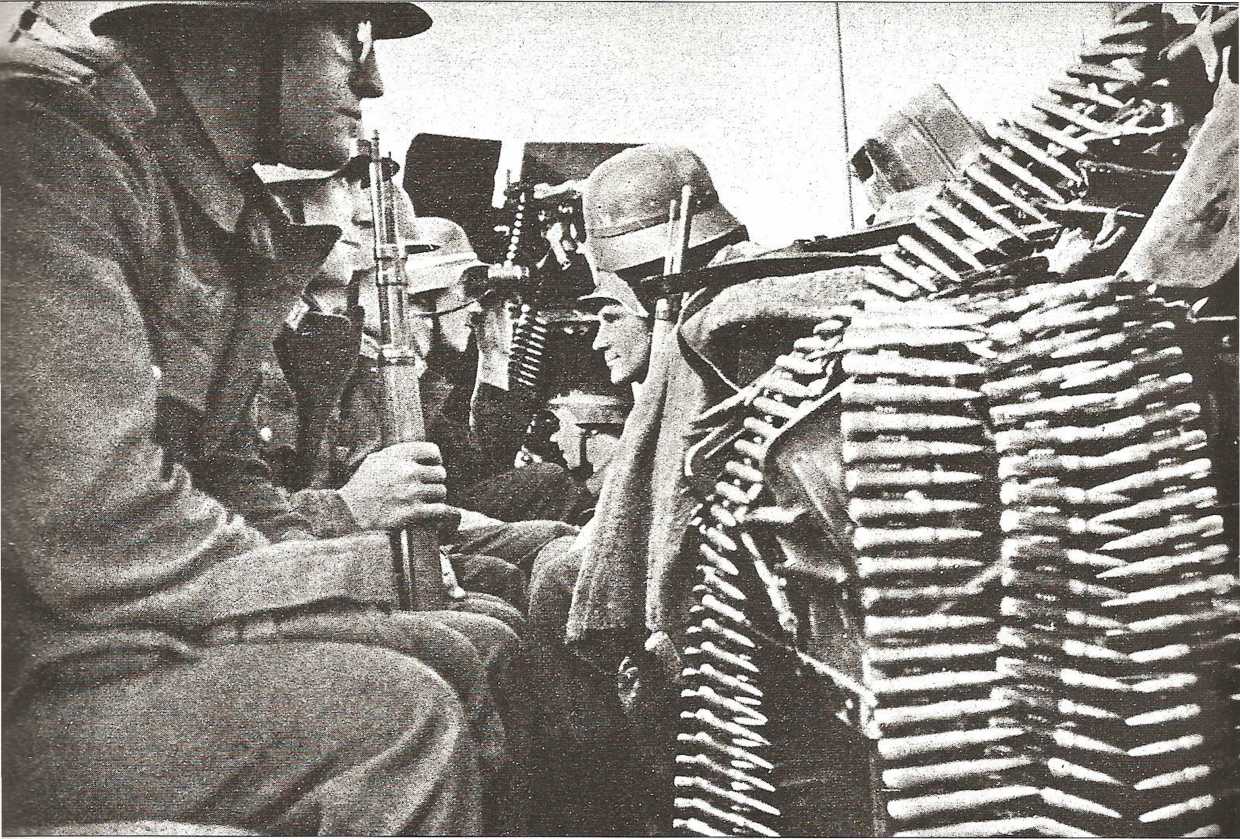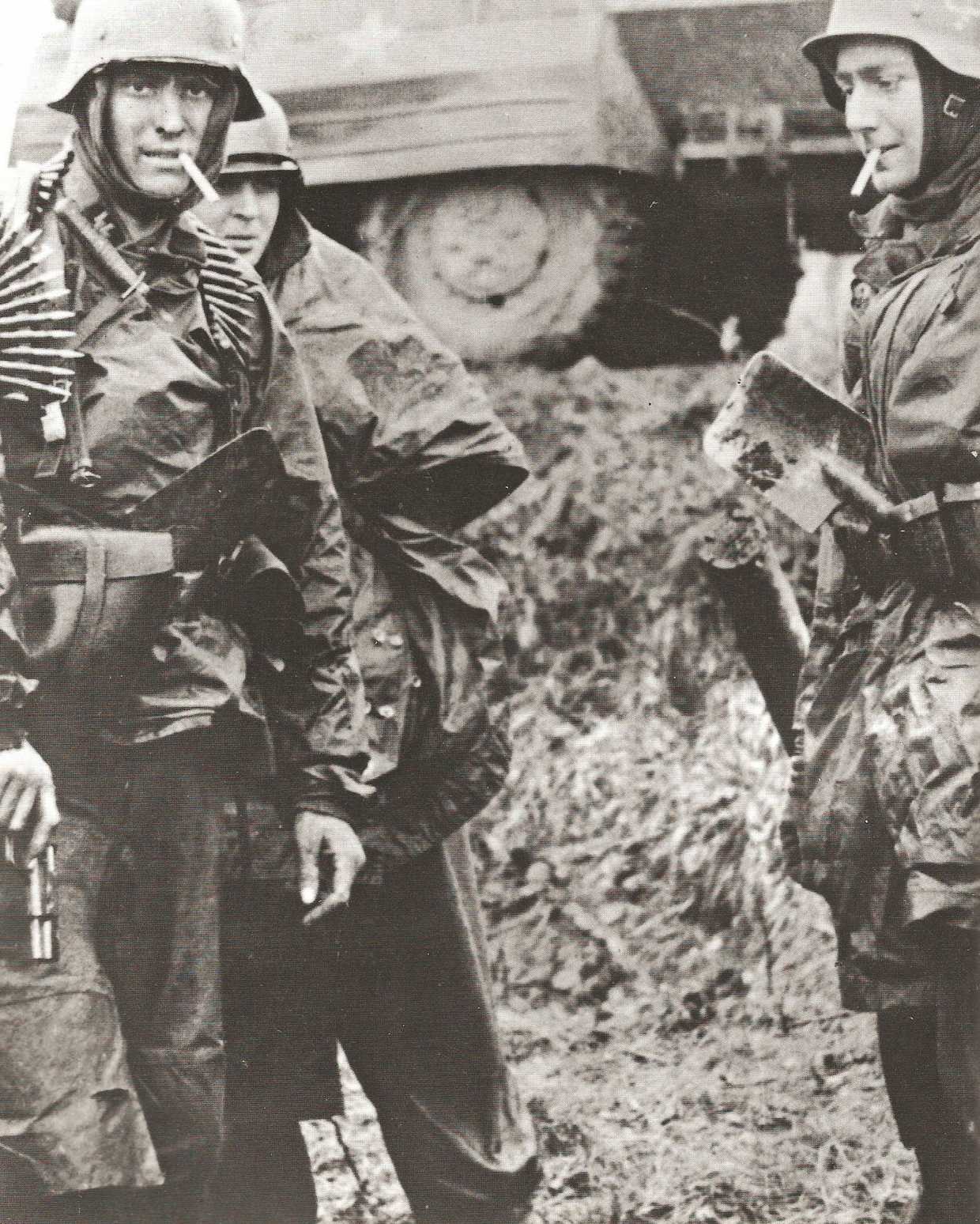3rd Panzer Grenadier Division fought in Italy and northern Europe following its reconstruction after Stalingrad. It was trapped and destroyed in the Ruhr Pocket in April 1945.
10th Panzer Grenadier Division fought in the east until its remnants surrendered to the Soviets in Czechoslovakia at the end of the War.
15th Panzer Grenadier Division was formed from the remnants of 15th Panzer Division in Sicdy in the summer of 1943. It fought with distinction in the Italian campaign but finished the war in northwest Europe.
16th Panzer Grenadier Division served in Yugoslavia and the east until converting to a panzer division in March
1944.
18th Panzer Grenadier Division served in the east, broke out of the encirclement at Minsk and survived long enough to fight in the Battle of Berlin in the last days of the War.
20th Panzer Grenadier Division also fought in the east and Poland, until defending the Seelow Heights outside Berlin, where it was destroyed in May 1945.
25th Panzer Grenadier Division fought in the central sector of the Eastern Front for three years before being transferred to the west for refitting. It fought in the Battle of the Bulge and was tlien transferred to Berlin during tlie last Soviet offensive. Most of its survivors, however, managed to escape west and surrender to the British and Americans.
29th Panzer Grenadier Division fought in Poland, France and later the east, where it was destroyed at Stalingrad. The rebuilt Division fought in Italy until destroyed by the British 8th Army in April 1945.
90th Panzer Grenadier Division, which as a light division fought in north Africa, was destroyed in Tunisia in May 1943. The reformed Division fought throughout the Italian campaign and was destroyed near Bologna in April
1945.
Brandenburg Panzer Grenadier Division was formed from the Abwehr special forces unit. It fought on the Eastern Front until the end of the War.
Feldherrnhalle Panzer Grenadier Division suffered heavily when the massive Soviet summer offensive of 1944 annihilated Army Group Centre. It was finally destroyed during the siege of Budapest.
Grossdeutschland Panzer Grenadier Division, was an elite formation that fought exceptionally well throughout the war and was redesignated a panzer division in the winter of 1943-44. It ended the war defending East Prussia.
Kurmark Panzer Grenadier Division was an ad-hoc formation, which formed in the last days of the war and never exceeded regimental strength. It was a panzer division in name only.
Fuhrer Grenadier Division was organised in early 1945 and fought in the Battle of Vienna as part of Sixth SS Panzer Army.
Fuhrer Escort Division was formed originally as an escort battalion for Hitler and was expanded to divisional size in lanuary 1945.
As for the 14 SS panzergrenadier divisions, the 1st, 2nd, 3rd, 5th, 9th, 10th and 12th all became SS panzer divisions in October 1943. The 16th Reichsfiihrer SS Panzer Grenadier Division saw service in Italy and Hungary and was destroyed in Vienna in April 1945. The 17th Gotz Von Berlichingen fought in France and Germany after the Normandy landings. The 18th Horst Wesselwas formed in Hungary in 1944 and, unlike so many panzergrenadier divisions formed in this period, was properly equipped. It fought in the east, Poland and Slovakia and ended the War in the pocket east of Prague.
23rd SS Panzer Grenadier Division was formed from Dutch SS men in the last weeks of the war and fought in the Battle of Berlin. It never exceeded regimental strength.
34th Landsturm Nederland SS Panzer Grenadier Division
Was formed in Germany in 1943 mainly from Dutch personnel. It saw service in Yugoslavia but was transferred to Army Group North in December 1943. It was continuously engaged in the retreat through the Baltic States and ended the war in the Courland pocket. There was also a second parachute Hermann Goring Panzer Grenadier Division, which never reached full strength. The term parachute was honorary. It was assigned to the new Parachute Panzer Corps Hermann Goring and was smashed in East Prussia in early 1945. Its remnants were transferred south and ended the war in the Prague pocket.
Below: A panzergrenadier section demonstrating the usual method of debussing from an armoured halftrack on the Eastern Front. A machine gun is mounted at the rear of the halftrack for air defence, although it would probably be of little effective use.

Although the classic image of the panzergrenadier is intimately associated with the Sd Kfz 251 half-tracked armoured personnel carrier, there were never enough of these vehicles to equip panzergrenadier formations to full strength. The concept of a carrier-borne attack into the heart of the enemy’s defences accompanying the tanks was the ideal, but the reality was somewhat more mundane. Most panzer-grenadiers were transported in soft-skinned vehicles such as trucks and motorcycles. These were extremely vulnerable and thus considerable caution was required when following the tanks. There were no halftracks available in the Polish campaign, and later in the war very few panzergrenadier divisions had many of these vehicles. Even within the panzer divisions, only one battalion in two would be so equipped. Therefore, instead of driving into the midst of the enemy’s position, the panzergrenadiers normally debussed at a forming-up point or start line away from the enemy’s line of sight. They then attacked in the conventional manner of infantry supporting tanks. The key tactical advantage was that because of their motorisation, they could be brought into battle as soon as they were needed.
It was only at the time of the invasion of the Soviet Union in 1941 that large numbers of Sd Kfz 251s became widely available enough to equip full battalions of panzergrenadiers within panzer divisions. Now, the Germans could experiment with fighting directly from their half-tracks. Although the
Sd Kfz 251 provided decent protection against small arms fire, they only had 13mm (0.51in) of armour-plate. Thus, they were extremely vulnerable to even the smallest calibre anti-tank weapons and suffered accordingly. Due to the heavy losses suffered amongst the halftracks when accompanying the tanks into the heart of the battle, the Germans fairly quickly resorted to debussing at least 400m or so in front of the enemy’s positions, even when using the Sd Kfz 251. Nonetheless, under certain tactical conditions, the halftrack could provide a useful firing position.
At the lowest level, the basic panzergrenadier unit was the gruppe or squad, usually of 12 men mounted in a halftrack or often a truck. The squad was led by a squad leader, usually a junior NCO such as a corporal, who was armed with a machine pistol and was responsible for the squad to the platoon commander. On the move, he also commanded the vehicle and fired the vehicle-mounted machine-gun. His rifle-armed assistant was normally a lance corporal, and could lead half the squad if it was divided. The squad contained two light machine-gun teams, each of two men, four rifle-armed infantrymen and the driver and co-driver. The
The classic German tactic of a Kesselschlacht, or ‘Cauldron Battle’, where the enemy’s defensive positions are outflanked, surrounded, and slowly reduced. This was a particular feature of the invasion of Russia in 1941.

Driver was also responsible for the care of the vehicle and expected to remain with the transport. A panzergrenadier platoon was made up of three squads, with the platoon headquarters in a separate vehicle. The headquarters troop consisted of a platoon commander, usually a junior officer but sometimes a sergeant, a driver, a radio operator, two runners, a medic and usually some form of anti-tank gun.
When the squad was transported by a halftrack, the vehicle was mounted from the rear. The deputy squad leader was responsible for closing the door, thus he would sit towards the rear of the vehicle and the squad leader would sit towards the front. These vehicles were open-topped, and on the move it was usual for one man to scan the skies constantly for aircraft, whilst the others kept a watch on both sides of the vehicle. When a platoon was driving together, close order for the convoy was usually 5-1 Om apart in column or even abreast in open country. In combat, however, the gaps were extended to beyond 50m, and ragged lines or chequered formations were used. If the whole battalion was deployed, the preferred formation was often an arrowhead. On the whole, troop-carrying vehicles rarely averaged more than 30km per hour road speed. Even under ideal conditions, a panzer division was not expected to advance more than 200km in a day.
The Sd Kfz 251 drivers were prepared to simply ignore or drive through small arms fire, but the presence of enemy artillery or anti-tank guns usually forced the halftracks to seek cover. The squad’s machine-gunners might well engage targets on the move, as could the rest of the squad if necessary from the sides of the vehicle. Often when advancing, the Sd Kfz 251s could utilise a motorised version of fire and movement, advancing, stopping and firing to cover the other halftracks. A halted halftrack provided a decent fire platform but was extremely vulnerable. As a result, it was not recommended to stop for more than 15-25 seconds in hostile terrain. The normal dismounting procedure was through the rear of the vehicle. However, in emergencies, the squad might well jump over the sides as well as out of the back. This was often performed on the move at slow speeds. Once dismounted, the panzergrenadiers fought as

Above: A fully loaded halftrack with abundant reserves of ammunition for the MG34 machine gun. The Germans relied heavily on machine gun fire support in battle, although panzergrenadiers rarely fought from inside their vehicles.
Normal infantry. Improvements in Soviet anti-tank defences as the war advanced meant that the panzergrenadiers often had to precede the tanks, or a mixed force of tanks and soldiers might move forward to clear the enemy defences.
One of the most important German formations developed during the Soviet campaign was the pulk, a contraction of panzer und lastkraftwagen, meaning tanks and trucks. This was a hollow wedge of tanks inside which moved the motorised infantry. The point of the wedge was formed by the best tanks and the sides by other tanks and self-propelled guns. When the wedge pierced the enemy defences, it widened the gap as it passed through. The motorised infantry were then able to spread out and attack any remaining areas of resistance from the flank and rear. If the enemy’s weakest point had not been identified, the pulk could advance as a blunt quadrangle. Once a weak spot was found, the formation could incline left or right, its corner becoming the point of advance.
Although the panzergrenadiers’ key role was cooperation with tanks, they could also operate on their own. Their very flexibility was a vital component of their value. They could fight traditional infantry offensive and defensive actions, assault vital strongpoints, seize bridges and clear urban or wooded areas in which tanks were vulnerable. Essentially, the panzergrenadier was part of an all-arms team. His role had grown out of the German acceptance that the tank could not win battles alone. To quote Wilhelm Necker in 1943: ‘The Germans at an early stage of the war and even before the war understood the special weakness of the tank: its dependency on terrain and the fact it cannot occupy, but can only strike hard and break through the lines. For this reason, the actual tank force was cut down to the very minimum and the division reinforced with various other units, the most important of which is the Panzer Grenadier regiment.’ How these regiments performed is recounted in the next two chapters.





 World History
World History









